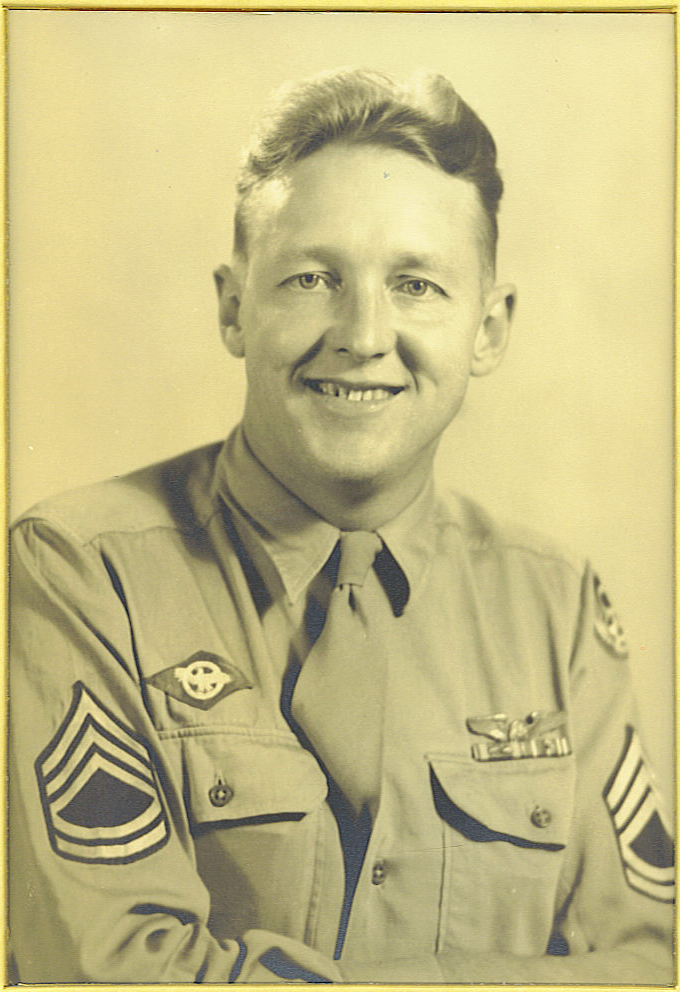World War II Experiences

The Luft IV Memorial
Committee has an ongoing project to construct a display of
bricks on the premises of the former POW camp site in memory of
those prisoners interned at Stalag Luft IV. -- click here
for more info!
Richard was drafted into the Army Air Corps in
October 1942. At the time he had been a welder in a shipyard in
Tacoma, WA for six months, making $1.50/hour.
He was processed at Fort Lewis, WA and then took a train to HIll
Field in Ogden, UT where he spent about two weeks. Richard was
assigned as a radio operator and backup top turret gunner on a
B-24. Coincidently, the woman (Evelyn Bashore) he would
eventually meet and marry 20 years later was calibrating bomber
turrets at Hill Field.
From Utah he took a train to Sioux Falls, ID to attend radio
school for four months. Being the small world it is, his current
wife's (Nathalie Halverson-Hanson) first husband, Clair, had
also attended the same school.
After radio school it was off to gunnery school in Kingman, AZ
for six weeks. At first they would fly in a North American AT-6 shooting at a towed
target with hand-help .30 caliber machine gun. Afterwards they
trained on .50 caliber machine guns in a Lockheed AT-18. They also did some gunnery
practice on the ground.
His next stop was Boise, ID where the 445th Bomb Group of the
8th Air Force was being formed. He was assigned to a B-24 crew in the 702nd Bomb
Squadron who's pilot was 1st Lt. Joe Pavelka. The actor, Jimmy
Stuart, was the commanding officer of another squadron during
the same period. There were six or seven planes in the squadron
and four squadrons per group.
The squadron moved on to Pocatello, ID for more training. The
next stop was Sioux City, IA for training on night and day
missions. From there they spent two weeks in North Dakota. Then
they flew to Plattsburg, NY for 2 weeks. By this time is was
around October 1943. They flew on to Lincoln, NE in November to
prepare for their overseas flight. They took the southern route
to England due to the winter weather. Here's the route and
flight times as documented in his flight records:
| Date |
Depart From |
Arrive At |
Flight Time |
Notes |
| 11/21/43 |
Lincoln, NE |
Macon, GA |
6:15 |
|
| 11/21/43 |
Macon, GA |
Miami, FL |
2:45 |
|
| 11/23/43 |
Miami, FL |
Puerto Rico |
5:55 |
|
| 11/24/43 |
Puerto Rico |
British Guiana |
5:25 |
|
| 11/25/43 |
British Guiana |
Belem, Brazil (Northern) |
5:50 |
|
| 11/27/43 |
Belem, Brazil (Northern) |
Natal, Brazil (East coast) |
5:42 |
|
| 11/30/43 |
Natal, Brazil (East coast) |
Dakar, Senegal |
10:35 |
Crossing the Atlantic |
| 12/1/43 |
Dakar, Senegal |
Marrakech, Morocco |
7:45 |
|
| 12/8/43 |
Marrakech, Morocco |
England (Southwest coast) |
9:30 |
|
| 12/11/43 |
England (Southwest coast) |
Tibenham, England |
3:45 |
Stationed here, North of London |
His first mission was on Christmas Eve 1943. He
flew to Osnabrook, Germany. They saw a lot of flak but no
fighters. They all wore flak suits and helmets. At one point he
saw a flaming bomber going down in a flat spin. His first
thought at the sight of this flaming pinwheel was that the
Germans must be shooting some new weapon at them.
They always flew day missions against German factories and
airfields.
He was on the first successful mission to Berlin.
On one mission he saw, out the open bomb bay, a ME109
flying about 200 yards directly below them.
In all his missions he never saw any b-24s with the ball turret
deployed.
On the day his plane was shot down they were attacked by
fighters coming in low from the rear. He has always felt that
the tail gunner was asleep when they were attacked.
They flew with fighter cover. P-47 Thunderbolts flew the first leg of the
mission, P-38 Lightnings flew the second leg and P-51 Mustangs flew cover for the farthest
portion of their missions.
During one mission he heard pieces of flak rattling around the
inside of the plane.
He was responsible for opening the bomb bay doors.
|
